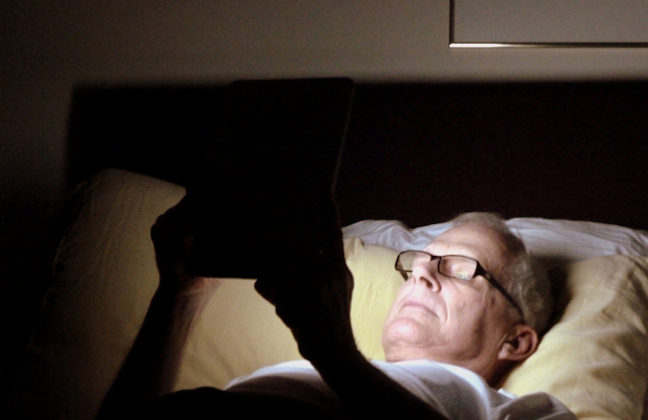Can’t Go To Sleep At Night? It Might Be Your iPad, Kindle Or Nook’s Fault
If you’re having a difficult time falling asleep after reading a few chapters of the latest can’t-put-it-down book, the bright light emitted from your eReader may to blame.
The Wall Street Journal reports that a study [PDF] from Brigham and Women’s Hospital in Boston – published in the journal Proceedings of the National Academy of Sciences – added another electronic device to the long list of items that you shouldn’t be using before hitting the hay.
According to the study, the type of short-wavelength enriched light, also known as blue light, that many backlit devices emit is especially powerful at suppressing the release of melatonin, a hormone that helps bring on sleep.
Charles Czeisler, the study’s senior author and chief of the hospital’s division of sleep and circadian disorders, says that having that blue light shining directly in your eyes “is exactly what you don’t want to do at bedtime.”
“Many people read things to help them fall asleep,” he says. “They probably don’t realize that this technology is actually making them less likely to feel sleepy.”
In the study, 12 healthy adults spent two weeks in a sleep lab, reading on either an iPad set to a maximum brightness or a printed book for four hours before an enforced bedtime of 10 p.m. for five consecutive nights. After the first five days, the subjects switched reading methods.
On average, participants who read from the iPads took nearly 10 minutes longer to fall asleep than those who read the printed books. Sleep monitors showed that these participants had less rapid-eye movement (REM) sleep after using the iPads.
Subsequent blood tests on their melatonin levels found their circadian rhythms were delayed by as much as an hour. Additionally, the test subjects rated themselves as less sleepy before bedtime and said it took them longer to become fully alert in the morning after reading on an iPad the night before.
Researchers say that while the iPad was the only device tested in this manner, other devices such as iPhones, iPods, the Nook Color and the Kindle Fire all have similar short-wavelength emissions; meaning their use would likely have the same effect.
But not all eReaders cause the user to lose sleep. The original Kindle, which doesn’t have its own light source, reflects the same ambient light as a regular book, the study says. Other Kindle devices, like the Paperwhite and Voyage, also use different light technology designed to be easier on the eyes, however these devices were not tested in the study.
To lessen the impact on sleep, Czeisler suggests consumers who just can’t put their books down, try to adjust their screen’s brightness or switch to white text on a black background.
Czeisler tells the WSJ that his lab plans to conduct a follow-up study in which participants won’t have an enforced bedtime and he expected the sleep-delaying effect of the eReader to be even greater.
Open the Book, Put Down the Tablet at Bedtime [The Wall Street Journal]
Want more consumer news? Visit our parent organization, Consumer Reports, for the latest on scams, recalls, and other consumer issues.


